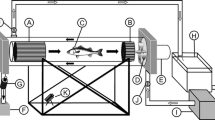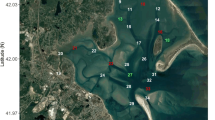Abstract
The effect of water temperature on white-spotted conger activity was examined using acoustic accelerometer transmitters to understand thermal effects on the behavior of a target fishery species. We recorded swimming activities of 21 congers using video cameras and compared the body undulation frequency with acceleration values measured using accelerometer transmitters in the body cavity. We found a significant, positive, linear relationship between the acceleration values and activity (body undulation frequency) of congers. We conducted a calibration trial to evaluate the relationships between conger activities and acceleration values measured using accelerometer transmitters, which confirmed the body undulation frequency of congers was associated with its swimming activity. We also examined the effect of water temperature on conger activity levels. The activity levels of eight congers at water temperatures from 10 to 28 °C were tested using accelerometer transmitters. We found a positive relationship between the conger activity levels and water temperatures between 10 and 26 °C, whereas the activity declined between 26 and 28 °C. These results demonstrate that accelerometer transmitters can quantitatively measure changes in the activity of white-spotted conger with water temperature in nature.





Similar content being viewed by others
References
Brander K, Blom G, Borges MF, Erzini K, Henderson G, MacKenzie BR, Mendes H, Ribeiro J, Santos AMP, Toresen R (2003) Changes in fish distribution in the eastern North Atlantic: are we seeing a coherent response to changing temperature? ICES Mar Sci Sym 219:261–270
Brownscombe JW, Gutowsky LFG, Danylchuk AJ, Cooke SJ (2014) Foraging behaviour and activity of a marine benthivorous fish estimated using tri-axial accelerometer biologgers. Mar Ecol Prog Ser 505:241–251
Castonguay M, Cyr DC (1998) Effects on temperature on spontaneous and thyroxine-stimulated locomotor activity of Atlantic cod. J Fish Biol 53:303–313
Claireaux G, Lagardère JP (1999) Influence of temperature, oxygen and salinity on the metabolism of the European sea bass. J Sea Res 42:157–168
D’Août K, Aerts P (1999) A kinematic comparison of forward and backward swimming in the eel Anguilla anguilla. J Exp Biol 202:1511–1521
Gannon R, Taylor MD, Suthers IM, Gray CA, van der Meulen DE, Smith JA, Payne NL (2014) Thermal limitation of performance and biogeography in a free-ranging ectotherm: insights from accelerometry. J Exp Biol 217:3033–3037
Gillis GB (1998) Environmental effects on undulatory locomotion in the American eel Anguilla rostrata: kinematics in water and on land. J Exp Biol 201:949–961
Gorie S, Ohtani T (1997) Growth of the juvenile white-spotted congers under experimental conditions. Suisanzoshoku 45:485–488 (in Japanese with English abstract)
Hussey NE, Kessel ST, Aarestrup K, Cooke SJ, Cowley PD, Fisk AT, Harcourt RG, Holland KN, Iverson SJ, Kocik JF, Mills Flemming JE, Whoriskey FG (2015) Ecology. Aquatic animal telemetry: A panoramic window into the underwater world. Science 348:1255642
Katayama S, Ishida T, Shimizu Y, Yamanobe A (2004) Seasonal change in distribution of Conger eel Conger myriaster off the Pacific coast south of Tohoku, north-eastern Japan. Fish Sci 70:1–6
Kern S, Koumoutsakos P (2006) Simulations of optimized anguilliform swimming. J Exp Biol 209:4841–4857
Kobayashi N (1989) Fisheries and ecology of conger eel in Sendai bay. Proceedings North Groundfish Group meeting. Fish Res Invest Sci Fish Agency Jpn Gov 22:95–106 (in Japanese)
Lee CG, Farrell AP, Lotto A, MacNutt MJ, Hinch SG, Healey MC (2003) The effect of temperature on swimming performance and oxygen consumption in adult sockeye (Oncorhynchus nerka) and coho (O. kisutch) salmon stocks. J Exp Biol 206:3239–3251
Mochioka N, Tokai T (2001) Fisheries biology and fisheries of white-spotted conger-eel Conger myriaster. Kaiyo Monthly 33:525–528 (in Japanese)
Müller UK, Smit J, Stamhuis EJ, Videler JJ (2001) How the body contributes to the wake in undulatory fish swimming: flow fields of a swimming eel (Anguilla anguilla). J Exp Biol 204:2751–2762
Murchie KJ, Cooke SJ, Danylchuk AJ, Suski CD (2011) Estimates of field activity and metabolic rates of bonefish (Albula vulpes) in coastal marine habitats using acoustic tri-axial accelerometer transmitters and intermittent-flow respirometry. J Exp Mar Biol Ecol 396:147–155
Nemoto Y, Yamada M, Ishida T (2006) Fishery and resource management of white-spotted conger in Fukushima Prefecture. Tohoku Sokouo Kenkyu 26:92–97 (in Japanese)
O’Toole AC, Murchie KJ, Pullen C, Hanson KC, Suski CD, Danylchuk AJ, Cooke SJ (2010) Locomotory activity and depth distribution of adult great barracuda (Sphyraena barracuda) in Bahamian coastal habitats determined using acceleration and pressure biotelemetry transmitters. Mar Freshw Res 61:1446–1456
Payne NL, Gillanders BM, Seymour RS, Webber DM, Snelling EP, Semmens JM (2011) Accelerometry estimates field metabolic rate in giant Australian cuttlefish Sepia apama during breeding. J Anim Ecol 80:422–430
Shimizu T (2003) On the resource of white-spotted conger Conger myriaster in Tokyo Bay. Bull Kanagawa Pref Fish Res Inst 8:1–11 (in Japanese)
Stehfest KM, Lyle JM, Semmens JM (2015) The use of acoustic accelerometer tags to determine seasonal changes in activity and catchability of a recreationally caught marine teleost. ICES J Mar Sci 72:2512–2520
Stoner AW, Sturm EA (2004) Temperature and hunger mediate sablefish (Anoplopoma fimbria) feeding motivation: implications for stock assessment. Can J Fish Aquat Sci 61:238–246
Stoner AW, Ottmar ML, Hurst TP (2006) Temperature affects activity and feeding motivation in Pacific halibut: implications for bait-dependent fishing. Fish Res 81:202–209
Wada T, Shimamura S, Nemoto Y (2014) Feeding, growth, and dispersal of hatchery-reared spotted halibut Verasper variegatus released in a shallow brackish lagoon: Matsukawa-ura, northeastern Fukushima, Japan. Aquacult Sci 62:75–88
Welch DW, Ishida Y, Nagasawa K (1998) Thermal limits and ocean migrations of sockeye salmon (Oncorhynchus nerka): long-term consequences of global warming. Can J Fish Aquat Sci 55:937–948
Wilson SM, Hinch SG, Eliason EJ, Farrell SP, Cooke SJ (2013) Calibrating acoustic acceleration transmitters for estimating energy use by wild adult Pacific salmon. Comp Biochem Phys A 164:491–498
Yokota T, Machida M, Takeuchi H, Masuma S, Masuda R, Arai N (2011) Anti-predatory performance in hatchery-reared red tilefish (Branchiostegus japonicus) and behavioral characteristics of two predators: acoustic telemetry, video observation and predation trials. Aquaculture 319:290–297
Yoshida N, Mitamura H, Okamoto H, Arai N (2015) Measurement of activity for sit-and-wait predator, red-spotted grouper, using acoustic acceleration transmitter. J Adv Mar Sci Technol Soc 21:1–5
Acknowledgements
We would like to thank Makoto Suzuki, Ikuo Matsumoto, Kaoru Narita, and other staff of Soma Branch of the Fukushima Prefectural Fisheries Experimental Station for their support during fish collections and rearing experiments. We also thank the staff at Kyoto University Maizuru Fishery Research Station, especially Reiji Masuda, Hideki Sawada, Kohji Takahashi, and Sanshiro Kaneko for experimental support. This study was mainly supported by a grant from the Fisheries Agency of Japan.
Author information
Authors and Affiliations
Corresponding author
Rights and permissions
About this article
Cite this article
Hori, T., Noda, T., Wada, T. et al. Effects of water temperature on white-spotted conger Conger myriaster activity levels determined by accelerometer transmitters. Fish Sci 85, 295–302 (2019). https://doi.org/10.1007/s12562-019-01289-0
Received:
Accepted:
Published:
Issue Date:
DOI: https://doi.org/10.1007/s12562-019-01289-0




